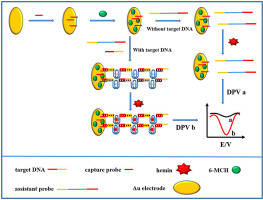当前位置:
X-MOL 学术
›
Anal. Chim. Acta
›
论文详情
Our official English website, www.x-mol.net, welcomes your
feedback! (Note: you will need to create a separate account there.)
Electrochemical detection of sequence-specific DNA based on formation of G-quadruplex-hemin through continuous hybridization chain reaction
Analytica Chimica Acta ( IF 5.7 ) Pub Date : 2018-08-01 , DOI: 10.1016/j.aca.2018.02.076 Xiaofan Sun , Haohan Chen , Shuling Wang , Yiping Zhang , Yaping Tian , Nandi Zhou
Analytica Chimica Acta ( IF 5.7 ) Pub Date : 2018-08-01 , DOI: 10.1016/j.aca.2018.02.076 Xiaofan Sun , Haohan Chen , Shuling Wang , Yiping Zhang , Yaping Tian , Nandi Zhou

|
A high-sensitive detection of sequence-specific DNA was established based on the formation of G-quadruplex-hemin complex through continuous hybridization chain reaction (HCR). Taking HIV DNA sequence as an example, a capture probe complementary to part of HIV DNA was firstly self-assembled onto the surface of Au electrode. Then a specially designed assistant probe with both terminals complementary to the target DNA and a G-quadruplex-forming sequence in the center was introduced into the detection solution. In the presence of both the target DNA and the assistant probe, the target DNA can be captured on the electrode surface and then a continuous HCR can be conducted due to the mutual recognition of the target DNA and the assistant probe, leading to the formation of a large number of G-quadruplex on the electrode surface. With the help of hemin, a pronounced electrochemical signal can be observed in differential pulse voltammetry (DPV), due to the formation of G-quadruplex-hemin complex. The peak current is linearly related with the logarithm of the concentration of the target DNA in the range from 10 fM to 10 pM. The electrochemical sensor has high selectivity to clearly discriminate single-base mismatched and three-base mismatched sequences from the original HIV DNA sequence. Moreover, the established DNA sensor was challenged by detection of HIV DNA in human serum samples, which showed the low detection limit of 6.3 fM. Thus it has great application prospect in the field of clinical diagnosis and environmental monitoring.
中文翻译:

基于G-四链体-氯化血红素连续杂交链反应形成的序列特异性DNA的电化学检测
基于通过连续杂交链反应(HCR)形成G-四链体-氯化血红素复合物,建立了序列特异性DNA的高灵敏度检测。以HIV DNA序列为例,与部分HIV DNA互补的捕获探针首先自组装到Au电极表面。然后将专门设计的两端与目标DNA互补、中心为G-四链体形成序列的辅助探针引入检测溶液中。在靶DNA和辅助探针同时存在的情况下,靶DNA可以被捕获在电极表面,然后由于靶DNA和辅助探针的相互识别,可以进行连续的HCR,导致形成电极表面有大量的 G-四链体。在血红素的帮助下,由于 G-四链体-氯化血红素复合物的形成,在差分脉冲伏安法 (DPV) 中可以观察到明显的电化学信号。峰值电流在 10 fM 至 10 pM 范围内与目标 DNA 浓度的对数线性相关。电化学传感器具有高选择性,可以从原始 HIV DNA 序列中清楚地区分单碱基错配和三碱基错配序列。此外,已建立的 DNA 传感器受到人血清样本中 HIV DNA 检测的挑战,其检测下限为 6.3 fM。因此在临床诊断和环境监测领域具有很大的应用前景。峰值电流在 10 fM 至 10 pM 范围内与目标 DNA 浓度的对数线性相关。电化学传感器具有高选择性,可以从原始 HIV DNA 序列中清楚地区分单碱基错配和三碱基错配序列。此外,已建立的 DNA 传感器受到人血清样本中 HIV DNA 检测的挑战,其检测下限为 6.3 fM。因此在临床诊断和环境监测领域具有很大的应用前景。峰值电流在 10 fM 至 10 pM 范围内与目标 DNA 浓度的对数线性相关。电化学传感器具有高选择性,可以从原始 HIV DNA 序列中清楚地区分单碱基错配和三碱基错配序列。此外,已建立的 DNA 传感器受到人血清样本中 HIV DNA 检测的挑战,其检测下限为 6.3 fM。因此在临床诊断和环境监测领域具有很大的应用前景。已建立的 DNA 传感器受到人血清样本中 HIV DNA 检测的挑战,其检测下限为 6.3 fM。因此在临床诊断和环境监测领域具有很大的应用前景。已建立的 DNA 传感器受到人血清样本中 HIV DNA 检测的挑战,其检测下限为 6.3 fM。因此在临床诊断和环境监测领域具有很大的应用前景。
更新日期:2018-08-01
中文翻译:

基于G-四链体-氯化血红素连续杂交链反应形成的序列特异性DNA的电化学检测
基于通过连续杂交链反应(HCR)形成G-四链体-氯化血红素复合物,建立了序列特异性DNA的高灵敏度检测。以HIV DNA序列为例,与部分HIV DNA互补的捕获探针首先自组装到Au电极表面。然后将专门设计的两端与目标DNA互补、中心为G-四链体形成序列的辅助探针引入检测溶液中。在靶DNA和辅助探针同时存在的情况下,靶DNA可以被捕获在电极表面,然后由于靶DNA和辅助探针的相互识别,可以进行连续的HCR,导致形成电极表面有大量的 G-四链体。在血红素的帮助下,由于 G-四链体-氯化血红素复合物的形成,在差分脉冲伏安法 (DPV) 中可以观察到明显的电化学信号。峰值电流在 10 fM 至 10 pM 范围内与目标 DNA 浓度的对数线性相关。电化学传感器具有高选择性,可以从原始 HIV DNA 序列中清楚地区分单碱基错配和三碱基错配序列。此外,已建立的 DNA 传感器受到人血清样本中 HIV DNA 检测的挑战,其检测下限为 6.3 fM。因此在临床诊断和环境监测领域具有很大的应用前景。峰值电流在 10 fM 至 10 pM 范围内与目标 DNA 浓度的对数线性相关。电化学传感器具有高选择性,可以从原始 HIV DNA 序列中清楚地区分单碱基错配和三碱基错配序列。此外,已建立的 DNA 传感器受到人血清样本中 HIV DNA 检测的挑战,其检测下限为 6.3 fM。因此在临床诊断和环境监测领域具有很大的应用前景。峰值电流在 10 fM 至 10 pM 范围内与目标 DNA 浓度的对数线性相关。电化学传感器具有高选择性,可以从原始 HIV DNA 序列中清楚地区分单碱基错配和三碱基错配序列。此外,已建立的 DNA 传感器受到人血清样本中 HIV DNA 检测的挑战,其检测下限为 6.3 fM。因此在临床诊断和环境监测领域具有很大的应用前景。已建立的 DNA 传感器受到人血清样本中 HIV DNA 检测的挑战,其检测下限为 6.3 fM。因此在临床诊断和环境监测领域具有很大的应用前景。已建立的 DNA 传感器受到人血清样本中 HIV DNA 检测的挑战,其检测下限为 6.3 fM。因此在临床诊断和环境监测领域具有很大的应用前景。











































 京公网安备 11010802027423号
京公网安备 11010802027423号